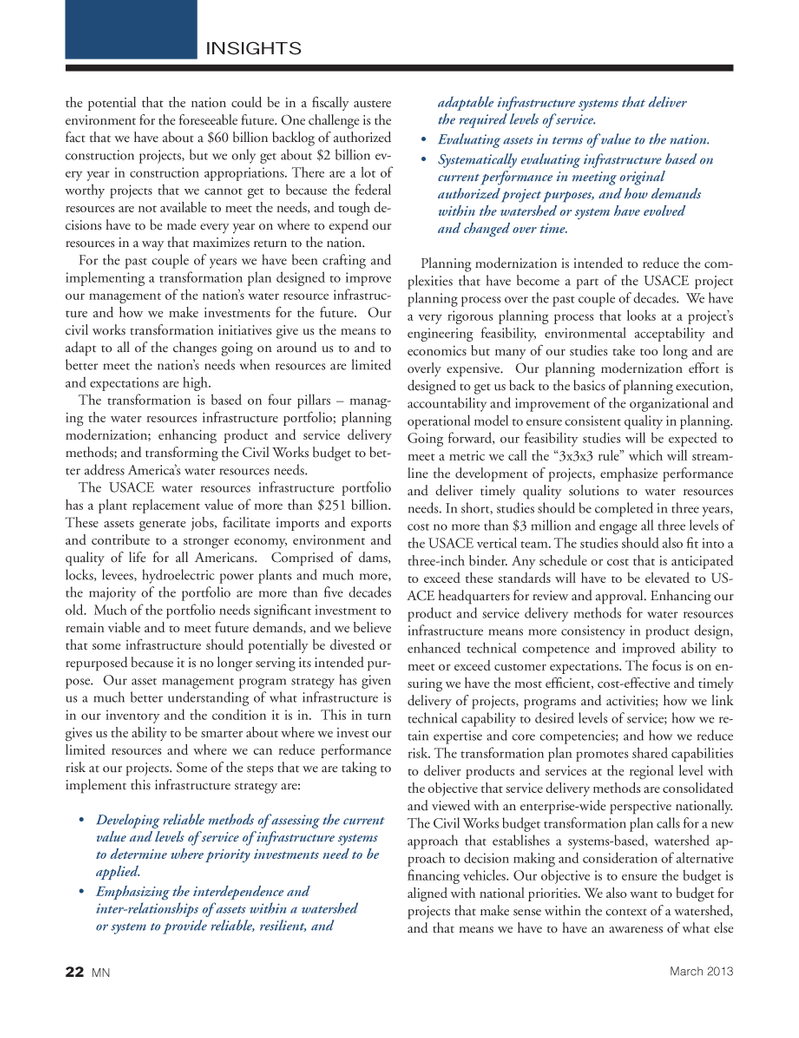
Page 22: of Marine News Magazine (March 2013)
Shipyard Report: Construction & Repair
Read this page in Pdf, Flash or Html5 edition of March 2013 Marine News Magazine
the potential that the nation could be in a Þ scally austere environment for the foreseeable future. One challenge is the fact that we have about a $60 billion backlog of authorized construction projects, but we only get about $2 billion ev- ery year in construction appropriations. There are a lot of worthy projects that we cannot get to because the federal resources are not available to meet the needs, and tough de- cisions have to be made every year on where to expend our resources in a way that maximizes return to the nation. For the past couple of years we have been crafting and implementing a transformation plan designed to improve our management of the nationÕs water resource infrastruc- ture and how we make investments for the future. Our civil works transformation initiatives give us the means to adapt to all of the changes going on around us to and to better meet the nationÕs needs when resources are limited and expectations are high. The transformation is based on four pillars Ð manag-ing the water resources infrastructure portfolio; planning modernization; enhancing product and service delivery methods; and transforming the Civil Works budget to bet- ter address AmericaÕs water resources needs. The USACE water resources infrastructure portfolio has a plant replacement value of more than $251 billion. These assets generate jobs, facilitate imports and exports and contribute to a stronger economy, environment and quality of life for all Americans. Comprised of dams, locks, levees, hydroelectric power plants and much more, the majority of the portfolio are more than Þ ve decades old. Much of the portfolio needs signiÞ cant investment to remain viable and to meet future demands, and we believe that some infrastructure should potentially be divested or repurposed because it is no longer serving its intended pur- pose. Our asset management program strategy has given us a much better understanding of what infrastructure is in our inventory and the condition it is in. This in turn gives us the ability to be smarter about where we invest our limited resources and where we can reduce performance risk at our projects. Some of the steps that we are taking to implement this infrastructure strategy are: Developing reliable methods of assessing the current value and levels of service of infrastructure systems to determine where priority investments need to be applied. Emphasizing the interdependence and inter-relationships of assets within a watershed or system to provide reliable, resilient, and adaptable infrastructure systems that deliver the required levels of service. Evaluating assets in terms of value to the nation. Systematically evaluating infrastructure based on current performance in meeting original authorized project purposes, and how demands within the watershed or system have evolved and changed over time. Planning modernization is intended to reduce the com- plexities that have become a part of the USACE project planning process over the past couple of decades. We have a very rigorous planning process that looks at a projectÕs engineering feasibility, environmental acceptability and economics but many of our studies take too long and are overly expensive. Our planning modernization effort is designed to get us back to the basics of planning execution, accountability and improvement of the organizational and operational model to ensure consistent quality in planning. Going forward, our feasibility studies will be expected to meet a metric we call the Ò3x3x3 ruleÓ which will stream- line the development of projects, emphasize performance and deliver timely quality solutions to water resources needs. In short, studies should be completed in three years, cost no more than $3 million and engage all three levels of the USACE vertical team. The studies should also Þ t into a three-inch binder. Any schedule or cost that is anticipated to exceed these standards will have to be elevated to US- ACE headquarters for review and approval. Enhancing our product and service delivery methods for water resources infrastructure means more consistency in product design, enhanced technical competence and improved ability to meet or exceed customer expectations. The focus is on en- suring we have the most efÞ cient, cost-effective and timely delivery of projects, programs and activities; how we link technical capability to desired levels of service; how we re- tain expertise and core competencies; and how we reduce risk. The transformation plan promotes shared capabilities to deliver products and services at the regional level with the objective that service delivery methods are consolidated and viewed with an enterprise-wide perspective nationally. The Civil Works budget transformation plan calls for a new approach that establishes a systems-based, watershed ap- proach to decision making and consideration of alternative Þ nancing vehicles. Our objective is to ensure the budget is aligned with national priorities. We also want to budget for projects that make sense within the context of a watershed, and that means we have to have an awareness of what else INSIGHTS22 MNMarch 2013 MN March2013 Layout 18-31.indd 22MN March2013 Layout 18-31.indd 223/1/2013 11:13:28 AM3/1/2013 11:13:28 AM

 21
21

 23
23
